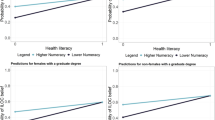Abstract
Literature suggests racial/ethnic minorities, particularly those who are less-acculturated, have stronger fatalistic attitudes toward cancer than do non-Latino Whites. Knowledge of cancer prevention is also lower among racial/ethnic minorities. Moreover, low knowledge about cancer risk factors is often associated with fatalistic beliefs. Our study examined fatalism and cancer knowledge by race/ethnicity and explored whether race/ethnicity moderate the association of fatalism with knowledge of cancer prevention and risk factors. We analyzed data from the Health Information National Trends Survey (2008), a national probability survey, to calculate population estimates of the associations among race/ethnicity, fatalistic beliefs, and knowledge about cancer from multivariable logistic regression. Racial/ethnic minorities had higher odds of holding fatalistic beliefs and lower odds of having knowledge of cancer risk factors than non-Hispanic Whites, and important differences by acculturation among Latinos were observed. Limited evidence of the moderating effect of race/ethnicity on the relationship between fatalistic beliefs and cancer risk factor knowledge was observed. Knowledge of cancer risk factors is low among all race/ethnicities, while fatalistic beliefs about cancer are higher among racial/ethnic minorities compared with non-Hispanic Whites. Implications for cancer education efforts are discussed.
Similar content being viewed by others
References
Abraído-Lanza AF, Chao MT, Flórez KR (2005) Do healthy behaviors decline with greater acculturation?: Implications for the Latino mortality paradox. Social Science & Medicine 61(6):1243–1255. doi:10.1016/j.socscimed.2005.01.016
Becker MH (1974) The health belief model and personal health behavior. C.B. Slack, Thorofare, N.J
Bennett GG, Wolin KY, Puleo EM, Masse LC, Atienza AA (2009) Awareness of national physical activity recommendations for health promotion among US adults. Med Sci Sports Exerc 41(10):1849–1855
Cameron LD, Leventhal H (2003) The self-regulation of health and illness behaviour. Routledge, London; New York
Cantor, D, Coa, K, Crystal-Mansour, S, Davis, T, Dipko, S, & Sigman, R (2009) Health Information National Trends Survey (HINTS) 2007: Final Report
Chavez LR, Hubbell FA, Mishra SI, Valdez RB (1997) The influence of fatalism on self-reported use of Papanicolaou smears. Am J Prev Med 13(6):418–424
De Los Monteros KE, Gallo LC, Elder JP, Talavera GA (2008). Individual and area based indicators of acculturation and the metabolic syndrome among low income Mexican American women living in a border region. Am J Public Health 98: 1979–1986
Fishbein M, Azjen I (2010) Predicting and changing behavior: the reasoned action approach. Psychology Press, New York
Han PK, Moser RP, Klein WM, Beckjord EB, Dunlavy AC, Hesse BW (2009) Predictors of perceived ambiguity about cancer prevention recommendations: sociodemographic factors and mass media exposures. Heal Commun 24(8):764–772
Harnack L, Block G, Subar A, Lane S, Brand R (1997) Association of cancer prevention-related nutrition knowledge, beliefs, and attitudes to cancer prevention dietary behavior. J Am Diet Assoc 97(9):957–965
Haskell WL, Lee IM, Pate RR, Powell KE, Blair SN, Franklin BA et al (2007) Physical activity and public health: updated recommendation for adults from the American College of Sports Medicine and the American Heart Association. Med Sci Sports Exerc 39(8):1423–1434
Hiatt RA, Rimer BK (1999) A new strategy for cancer control research. Cancer Epidemiol Biomarkers Prev 8(11):957–964
Krebs-Smith SM, Kantor LS (2001) Choose a variety of fruits and vegetables daily: understanding the complexities. J Nutr 131(2S-1):487S–501S
Lee CJ, Niederdeppe J (2011) Genre-specific cultivation effects. Commun Res 38(6):731–753
McClelland GH, Judd CM (1993) Statistical difficulties of detecting interactions and moderator effects. Psychol Bull 114(2):376–390
Nagler, RH (2013) Adverse outcomes associated with media exposure to contradictory nutrition messages (in press). J Health Comm (in press)
Nagler RH, Hornik RC (2012) Measuring media exposure to contradictory health information: a comparative analysis of four potential measures. Commun Methods Meas 6(1):56–75
Niederdeppe J, Levy AG (2007) Fatalistic beliefs about cancer prevention and three prevention behaviors. Cancer Epidemiol Biomarkers Prev 16(5):998–1003
Pate RR, Pratt M, Blair SN, Haskell WL, Macera CA, Bouchard C et al (1995) Physical activity and public health. A recommendation from the Centers for Disease Control and Prevention and the American College of Sports Medicine. JAMA, 273(5):402–407
Powe BD, Finnie R (2003) Cancer fatalism: the state of the science. Cancer Nurs 26(6):454–465, quiz 466-457
Ramírez AS (2013) Effects of ethnic targeting on the perceived effectiveness of cancer prevention messages among Latinas and non-Hispanic White women. J Health Comm (in press)
Seow A, Straughan PT, Ng EH, Emmanuel SC, Tan CH, Lee HP (1998) Population-based mammographic screening in Singapore: what are participants' views? Ann Acad Med Singapore 27(2):154–160
Shen L, Condit CM, Wright L (2009) The psychometric property and validation of a fatalism scale. Psychol Health 24(5):597–613
Spurlock WR, Cullins LS (2006) Cancer fatalism and breast cancer screening in African American women. ABNF J 17(1):38–43
Sullivan HW, Rutten LJ, Hesse BW, Moser RP, Rothman AJ, McCaul KD (2010) Lay representations of cancer prevention and early detection: associations with prevention behaviors. Prev Chronic Dis 7(1):A14
Viswanath K, Ackerson LK (2011) Race, ethnicity, language, social class, and health communication inequalities: a nationally-representative cross-sectional study. PLoS One 6(1):e14550
Acknowledgments
This project has been funded in part with federal funds from the National Cancer Institute, National Institutes of Health, under contract No. HHSN261200800001E. The content of this publication does not necessarily reflect the views or policies of the Department of Health and Human Services, nor does mention of trade names, commercial products, or organizations imply endorsement by the U.S. Government.
Author information
Authors and Affiliations
Corresponding author
Rights and permissions
About this article
Cite this article
Ramírez, A.S., Rutten, L.J.F., Oh, A. et al. Perceptions of Cancer Controllability and Cancer Risk Knowledge: The Moderating Role of Race, Ethnicity, and Acculturation. J Canc Educ 28, 254–261 (2013). https://doi.org/10.1007/s13187-013-0450-8
Published:
Issue Date:
DOI: https://doi.org/10.1007/s13187-013-0450-8




